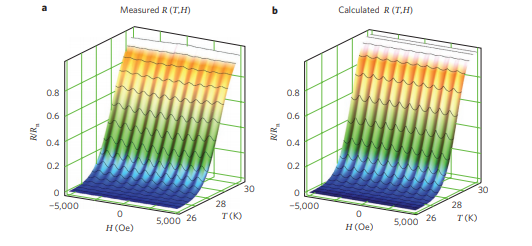Electron pairing in the pseudogap state revealed by shot noise in copper-oxide junctions
In the quest to understand high-temperature superconductivity in copper oxides, debate has been focused on the pseudogap-a partial energy gap that opens over portions of the Fermi surface in the 'normal' state above the bulk critical temperature1. The pseudogap has been attributed to precursor superconductivity, to the existence of preformed pairs and to competing orders such as charge-density waves1-4. A direct determination of the charge of carriers as a function of temperature and bias could help resolve among these alternatives. Here we report measurements of the shot noise of tunnelling current in high-quality La2-xSrxCuO4/La2CuO4/La2-xSrxCuO4 (LSCO/LCO/LSCO) heterostructures fabricated using atomic layer-by-layer molecular beam epitaxy at several doping levels. The data delineate three distinct regions in the bias voltage-temperature space. Well outside the superconducting gap region, the shot noise agrees quantitatively with independent tunnelling of individual charge carriers. Deep within the superconducting gap, shot noise is greatly enhanced, reminiscent of multiple Andreev reflections5-7. Above the critical temperature and extending to biases much larger than the superconducting gap, there is a broad region in which the noise substantially exceeds theoretical expectations for single-charge tunnelling, indicating pairing of charge carriers. These pairs are detectable deep into the pseudogap region of temperature and bias. The presence of these pairs constrains current models of the pseudogap and broken symmetry states, while phase fluctuations limit the domain of superconductivity.
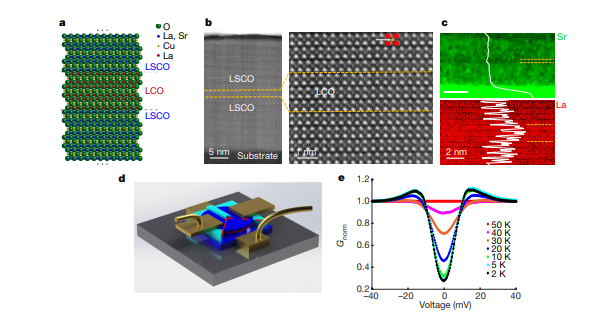
Non-sinusoidal current-phase relationship in Josephson junctions of the 3D topological insulator HgTe
We use superconducting quantum interference device microscopy to characterize the current-phase relation (CPR) of Josephson junctions from the three-dimensional topological insulator HgTe (3D HgTe). We find clear skewness in the CPRs of HgTe junctions ranging in length from 200 to 600 nm. The skewness indicates that the Josephson current is predominantly carried by Andreev bound states with high transmittance, and the fact that the skewness persists in junctions that are longer than the mean free path suggests that the effect may be related to the helical nature of the Andreev bound states in the surface of HgTe. These experimental results suggest that the topological properties of the normal state can be inherited by the induced superconducting state, and that 3D HgTe is a promising material for realizing the many exciting proposals that require a topological superconductor.s
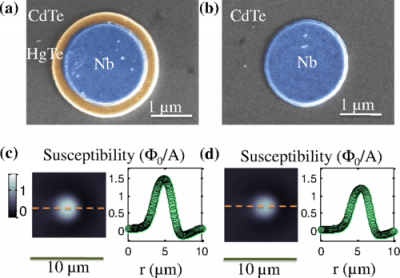
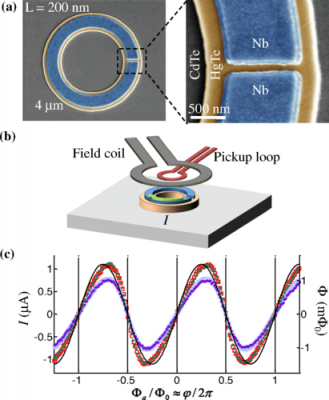
Direct measurement of current-phase relations in superconductor/ topological insulator/ superconductor junctions
Proximity to a superconductor is predicted to induce exotic quantum phases in topological insulators. Here, scanning superconducting quantum interference device (SQUID) microscopy reveals that aluminum superconducting rings with topologically insulating Bi2Se3 junctions exhibit a conventional, nearly sinusoidal 2π-periodic current-phase relations. Pearl vortices occur in longer junctions, indicating suppressed superconductivity in aluminum, probably due to a proximity effect. Our observations establish scanning SQUID as a general tool for characterizing proximity effects and for measuring current-phase relations in new materials systems.

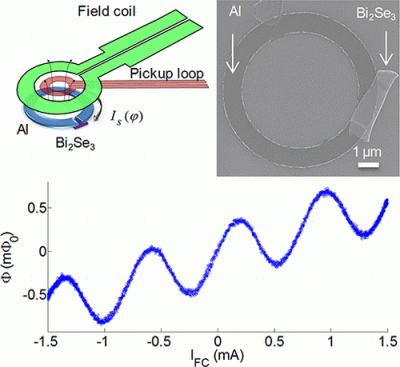
Large oscillations of the magnetoresistance in nano-patterned high-temperature superconducting films
Measurements on nanoscale structures constructed from high-temperature superconductors are expected to shed light on the origin of superconductivity in these materials. To date, loops made from these compounds have had sizes of the order of hundreds of nanometeres. Here, we report the results of measurements on loops of La1.84Sr0.16CuO4, a high-temperature superconductor that loses its resistance to electric currents when cooled below ∼38 K, with dimensions down to tens of nanometres. We observe oscillations in the resistance of the loops as a function of the magnetic flux through the loops. The oscillations have a period of h/2e, and their amplitude is much larger than the amplitude of the resistance oscillations expected from the Little-Parks effect. Moreover, unlike Little-Parks oscillations, which are caused by periodic changes in the superconducting transition temperature, the oscillations we observe are caused by periodic changes in the interaction between thermally excited moving vortices and the oscillating persistent current induced in the loops. However, despite the enhanced amplitude of these oscillations, we have not detected oscillations with a period of h/e, as recently predicted for nanoscale loops of superconductors with d-wave symmetry or with a period of h/4e, as predicted for superconductors that exhibit stripes.
